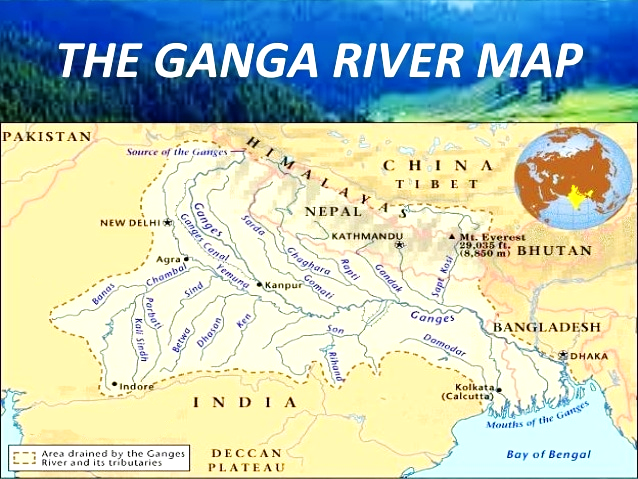NMCG & Namami Gange Programme | 12 Dec 2022
For Prelims: NMCG, Namami Gange programme, Arth Ganga, natural farming, SBM 2.0 , AMRUT 2.0, ‘Project Dolphin
For Mains: Significance of Namami Gange Programme in the Rejuvenation of River Ganga
Why in News?
Recently, the Union Minister for Jal Shakti chaired the 10th meeting of the Empowered Task Force (ETF) of National Mission for Clean Ganga (NMCG).
- As part of its flagship Namami Gange programme, the Union government has shifted its focus from improving sanitation to conservation, tourism, and economic development of the Ganga river.
What are the Recent Developments in Ganga Rejuvenation?
- Ministry of Tourism working on a comprehensive plan for development of tourism circuits along Ganga in line with Arth Ganga.
- ‘Arth Ganga’ implies a sustainable development model with a focus on economic activities related to Ganga.
- Exhibitions & Fairs across 75 towns along Ganga River planned as part of Azadi ka Amrit Mahotsav.
- Ministry of Agriculture & Farmers’ Welfare (MoA&FW) undertaking various steps to build organic farming and natural farming corridors along River Ganga
- Eco-agriculture being promoted besides efforts to improve water-use efficiency in Ganga villages by MoA&FW.
- Ministry of Housing and Urban Affairs focusing on mapping of urban drains and management of solid and liquid waste in Ganga towns under SBM 2.0 and AMRUT 2.0
- The Ministry of Environment, Forests and Climate Change mulling scaling up of afforestation activities in the Ganga belt and a detailed plan to take ‘Project Dolphin’ forward is also underway.
What is NMCG?
- About:
- It is being implemented by the National Council for Rejuvenation, Protection and Management of River Ganga also known as the National Ganga Council.
- This mission was established on 12th August 2011 under the Societies Registration Act,1860 as a registered society.
- Objectives:
- The mission incorporates rehabilitating and boosting the existing STPs (Sewage Treatment Plants) and instant short-term steps to curb pollution at exit points on the riverfront in order to check the inflow of sewage.
- To maintain the continuity of the water flow without changing the natural season variations.
- To restore and maintain the surface flow and groundwater.
- To regenerate and maintain the natural vegetation of the area.
- To conserve and regenerate the aquatic biodiversity as well as the riparian biodiversity of the river Ganga basin.
- To allow participation of the public in the process of protection, rejuvenation and management of the river.
What is Namami Gange Programme?
- About:
- Namami Gange Programme is an Integrated Conservation Mission, approved as a ‘Flagship Programme’ by the Union Government in June 2014 to accomplish the twin objectives of effective abatement of pollution and conservation and rejuvenation of National River Ganga.
- It is being operated under the Department of Water Resources, River Development and Ganga Rejuvenation, Ministry of Jal Shakti.
- The program is being implemented by the NMCG and its state counterpart organizations i.e State Program Management Groups (SPMGs).
- In phase 2 of Namami Gange Programme (2021-26), the states will focus on expeditious completion of projects and preparation of bankable Detailed Project Report (DPR) for projects in Ganga tributary towns, cutting down delays.
- Focus is also being given to the revival of small rivers and wetlands.
- For future, each Ganga district is to develop scientific plan and health card for at least 10 wetlands and adopt policies for reuse of treated water and other by products.
- Main Pillars:
- Sewage Treatment Infrastructure
- River-Front Development
- River-Surface Cleaning
- Biodiversity
- Afforestation
- Public Awareness
- Industrial Effluent Monitoring
- Ganga Gram
What are the Other Related Initiatives?
- Ganga Action Plan: It was the first River Action Plan that was taken up by the Ministry of Environment, Forest and Climate Change in 1985, to improve the water quality by the interception, diversion, and treatment of domestic sewage.
- The National River Conservation Plan is an extension to the Ganga Action Plan. It aims at cleaning the Ganga river under Ganga Action Plan phase-2.
- National River Ganga Basin Authority (NRGBA): It was formed by the Government of India in the year 2009 under Section-3 of the Environment Protection Act, 1986.
- It declared the Ganga as the ‘National River’ of India.
- Clean Ganga Fund: In 2014, it was formed for cleaning up of the Ganga, setting up of waste treatment plants, and conservation of biotic diversity of the river.
- Bhuvan-Ganga Web App: It ensures involvement of the public in monitoring of pollution entering into the river Ganga.
- Ban on Waste Disposal: In 2017, the National Green Tribunal banned the disposal of any waste in the Ganga.
UPSC Civil Services Examination, Previous Year Questions (PYQs)
Q. Discuss the Namami Gange and National Mission for Clean Ganga (NMCG) programmes and causes of mixed results from the previous schemes. What quantum leaps can help preserve the river Ganga better than incremental inputs? (2015)

